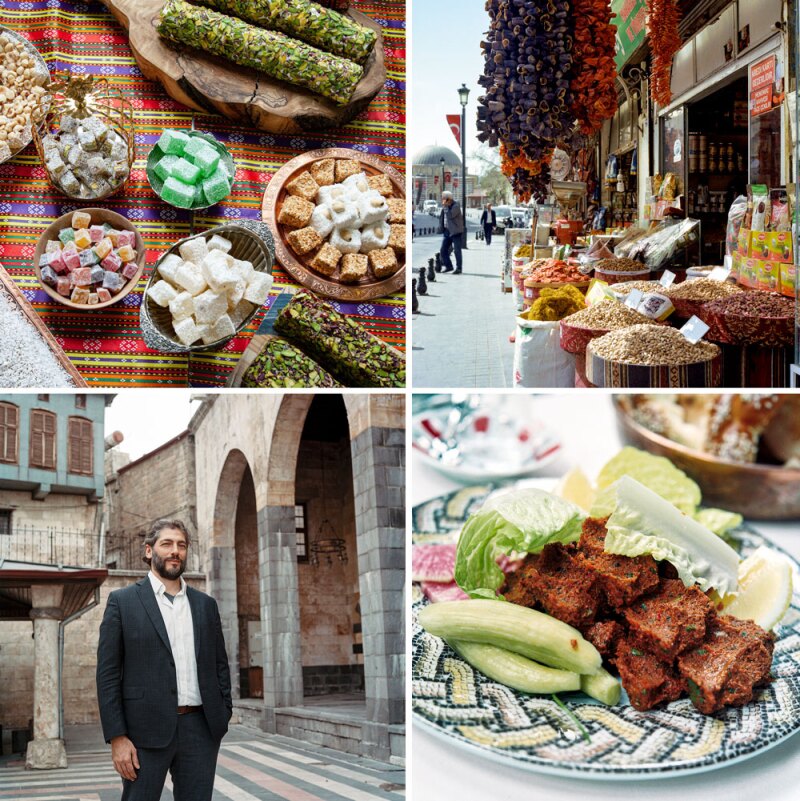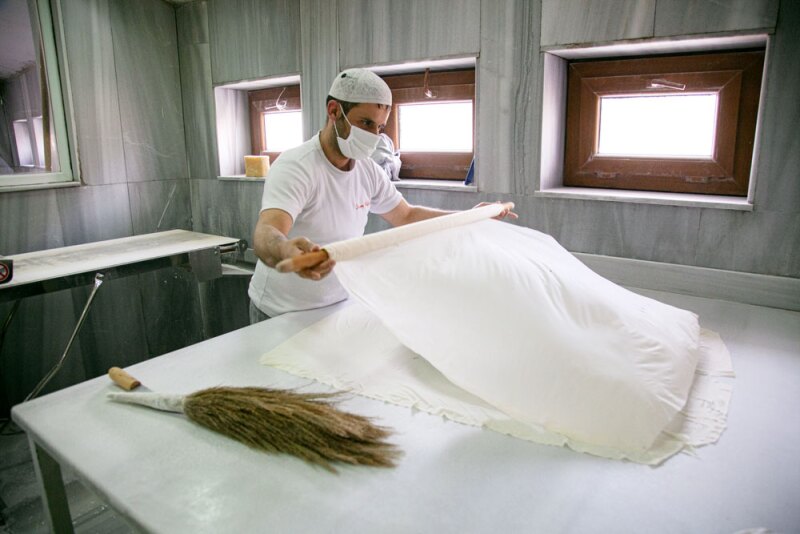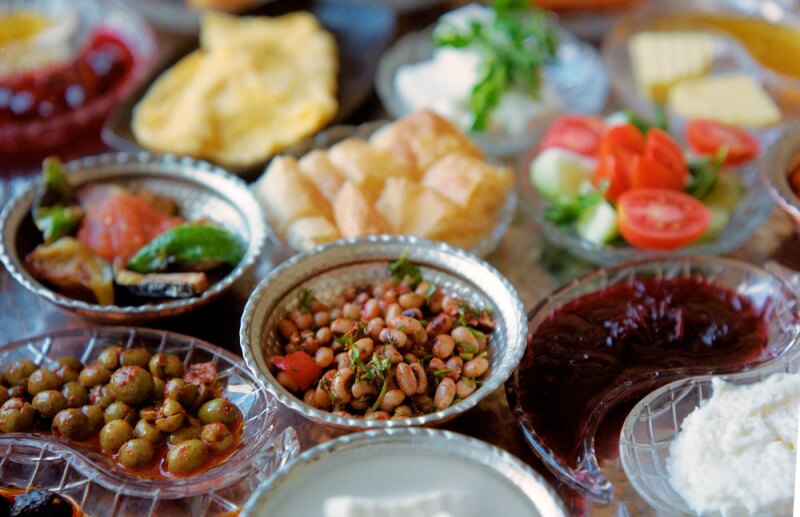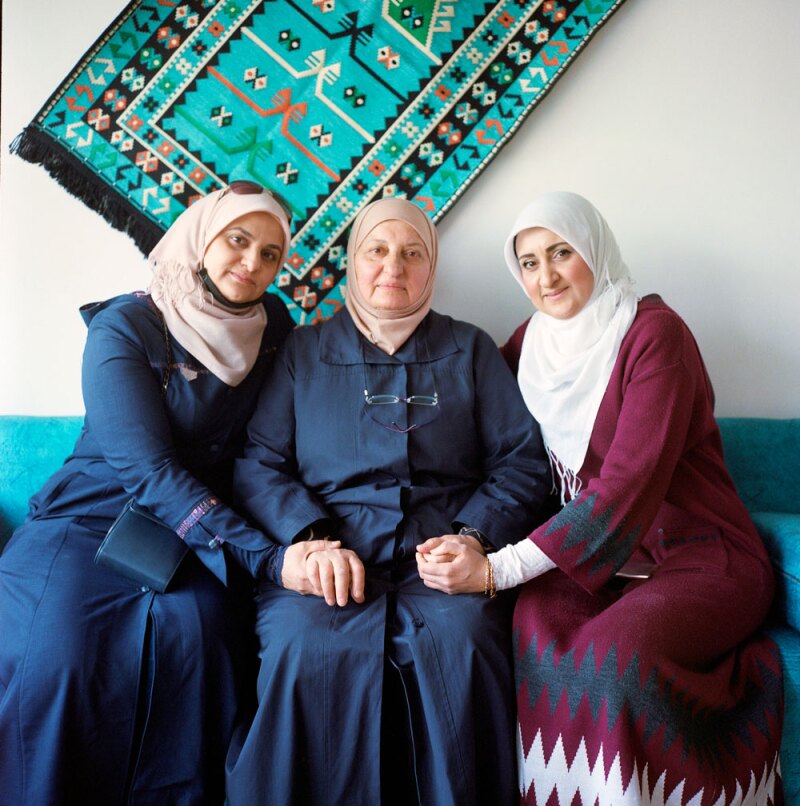IT’S 11 A.M. IN GAZIANTEP, a city in southeastern Türkiye, and I’m stunned by the sheer spectacle of our late breakfast. My partner, Barry, and I are at a restaurant called Orkide with our friend Filiz Hösükoğlu, an expert in local culture and food. Around us, guys in trim leather jackets and ladies—some in sparkly black tops, some in flowing hijabs—sip menengiç, a warm drink made from ground wild pistachios.
I circle our table in awe, trying to count and record all the dishes, losing track at three dozen. There are snowy clumps of kaymak (clotted buffalo cream) to be eaten with raw honey from the nearby hills; eggs scrambled with walnuts, fresh tarragon, and tiny roasted green olives; and eggs fried with topaç (beef confit). Copper bowls hold apricots stewed with fresh almonds and tahini the color of deep earth. All dishes seem touched by mint, live fire, and flakes of local red pepper.

Orkide’s chef and owner Mustafa Özgüler.
Photo by Rena Effendi
“This spread is my homage to our region’s Sunday tradition of potluck family breakfasts,” says Mustafa Özgugü̈ler, Orkide’s owner, as a vast platter of katmer arrives. A delicate cousin of the city’s prodigious baklava, katmer is made by wrapping layers of paper-thin pastry around pulverized pistachios with an almost preternatural intensity, and then baking it all to a sugary crunch. “Katmer is a cult, a drug . . .” Filiz murmurs.
I’d been dreaming about Gaziantep—Türkiye’s sixth-largest city, situated just west of the Euphrates River and north of the Syrian border, since I discovered its flavors in Istanbul two decades ago at Çiya, a celebrated restaurant specializing in southeastern Turkish cuisine. The food at Çiya was vibrant and inventive, wild with fresh herbs, pomegranate molasses, and şalça (sun-dried tomato and pepper pastes). It seemed worlds away from the delicate refinement of Istanbul cooking, and it launched in me a mild obsession with Gaziantep. Still, for years I hesitated to go, always too busy in Istanbul, and anxious perhaps that reality might not live up to my expectations. Meanwhile, the food hype only grew, especially when UNESCO named Gaziantep a Creative City of Gastronomy in 2015.
While I’d been putting off a visit, geopolitics in this region kept on its dark course. In 2011, Syrian president Bashar al-Assad’s regime began to use violence to suppress pro-democracy protests—tactics that eventually launched a ruinous civil war in Syria. During the next decade, that conflict would send more than 3.5 million refugees across the border to Türkiye. Megalopolis Istanbul absorbed some 550,000 arrivals. Gaziantep welcomed at least 500,000, ballooning its population by almost a third—and earning its mayor, Fatma Şahin, international praise for her savvy policies that prioritized integration and tolerance.
For the past several years, I’ve been researching a new book on food and nationalism, and soon after wrapping the text, I decided it was finally time for a visit. Like all food-obsessed pilgrims to Antep, as the locals call Gaziantep, I’d come for kebabs of grass-fed lamb, lahmacun (flatbreads with toppings) blistered in wood-fired ovens, and tiny bulgur dumplings bobbing in yogurt soup. Less blithely, I hoped to break bread with Syrians making a go of it. I wanted to learn how the new arrivals—most from war-ravaged Aleppo, once Syria’s largest city, 61 miles south—are reshaping the food culture of this singular borderland. From my book research, I was already familiar with Istanbul’s post-imperial Balkan Greek Armenian assemblage. Now I wanted to know more about what had been happening in Gaziantep—once a critical trading hub along the Silk Road—with its intertwined, ever-shifting layers of cuisines, identities, and cultural memories.

From top left: An array of Turkish delight; Spices on display in the historic center; Yakzan Shishakly, cofounder of the Maram Foundation; Lentil and bulgur patties from MSM Gaziantep.
Photos by Rena Effendi
“OF COURSE, A HUNDRED YEARS AGO there was no Türkiye or Syria.” This reminder comes from Cevdet and Murat Güllü, owners of Elmacı Pazarı Güllüoğlu, a legendary baklava shop in Antep’s historic bazaar quarter, and the second stop on my first day in town, with Filiz showing the way. Along with their pistachio confections, glistening with syrup and sheep’s butter, the brothers—whose great-grandfather founded the shop—offer historical context. They share that this region was once the Ottoman province of Haleb. Aleppo was the center of cuisine, culture, and commerce, and Antep was a provincial subdistrict.
In the mid-19th century, the Güllüs’ great-grandfather, Çelebi, stopped in Aleppo on his religious hajj from Antep to Mecca. Awed by the city’s baklava, he returned after his hajj to learn about the business, eventually moving back to Antep. In 1871, he started the shop that still exists today. By the time the Ottoman Empire officially dissolved in 1922—more than 70 years after the Güllüs’ great-grandfather apprenticed in Aleppo— war and politics had drastically rearranged borders, official identities, and historical destinies. Colonial powers carved up the Levant (now Israel, Palestine, Jordan, Lebanon, and Syria) into British and French spheres of influence, while Mustafa Kemal Atatürk— “Father Turk”—forged the modern republic of Türkiye. (The independent republic of Syria didn’t emerge until 1944.)
Almost instinctively, we tend to assign national identities to dishes, forgetting that borders are fluid, that so many of the boundaries we think of as fixed are both contorted and recent. And so, my mouth full of baklava, I ask the brothers, “Can one even say that baklava is Turkish or Syrian?” Well . . . they reply. It’s complicated. Because after Türkiye’s founding, Antep’s baklavaci (baklava makers) did develop a style of their own: stretching the pastry so thin you can almost see through it, then dusting the pastry with starch to make it more delicate, pouring hot syrup over hot baklava after its time in a wood-fired oven. The resulting confection is very different from the Aleppo original, which has thicker pastry and is drier and less sweet. Today, Filiz adds, Antep is legendary as Türkiye’s baklava capital, supplying 95 percent of what’s sold in the country.

A baker prepares pastry for baklava.
Photo by Rena Effendi
Leaving the brothers, Filiz leads us on a quick tour of the Coppersmith Bazaar’s vaulted lanes, which resound with the tuk-tuk-tuk of artisans stamping their wares. I feel lucky to have her as our guide. In addition to being a walking encyclopedia of local food mores, she’s an experienced NGO hand who specializes in integrating migrants through programs including vocational training. That night, for an introduction to the Syrian perspective on culinary and cultural matters, she arranges a dinner with her friend Yakzan Shishakly. We’re to meet at Hışvahan, a restaurant in a 16th-century caravansary (guesthouse) that’s been converted into a chic little hotel. When we arrive, Yakzan is already there, nursing a raki, Türkiye’s anise-flavored alcohol, at a candlelit table. “The food here’s outstanding,” he says. “Plus, it’s one of the few places in town serving drinks.” He looks like he needs one.
In his early forties, Yakzan evokes an empathetic bon vivant who has taken on a tragic, impossible job. A grandson of Adib Shishakli—one of Syria’s first presidents, who was assassinated in 1964—he grew up in Damascus. In 1999, he emigrated to Houston, became a U.S. citizen, and ran a successful air-conditioning business. Then, in 2011, “Syria happened,” as he puts it.
Heartsick and desperate to help, Yakzan soon found himself back in Syria, where he witnessed hundreds of internally displaced persons (IDPs) surviving in flimsy tents beneath olive trees. He started raising funds to build a camp just north of Idlib, 41 miles from Aleppo. By mid-2012, Yakzan’s Olive Tree, the first major displaced-persons camp in Syria, was a vast tent city of more than 20,000 IDPs. (Today, there are more than 180,000 IDPs in the camp.) Currently, his NGO, the Maram Foundation, manages five camps and gives logistical support to more than a dozen others. Although he can no longer travel freely in Syria for fear of kidnapping or assassination, from his office in Antep Yakzan addresses endless crises—to say nothing of the hopelessness of a war without end, a generation of kids in camps with no schools. How does he cope? A resigned little grin: “I listen to motivational speeches first thing each morning.”
Yet Yakzan doesn’t want to spend our dinner stereotyping Syrians as abject hands outstretched for NGO aid. This, he says, deprives them of dignity. The reality outside camps is of a normal lived life, especially in places such as Antep, which has absorbed a wide swath of Aleppo’s middle class. Though, he adds, the trauma is always close to the surface: sudden tears for no reason, a fight with a taxi driver.
“Is it a comfort that the culture and food are so similar?” I ask, remembering suddenly the piercing alienation I experienced tasting American dishes back in the 1970s, soon after my mother and I arrived in the United States as refugees from the USSR.
“Of course, it softens the culture shock,” Yakzan agrees as a waiter delivers spicy dips and stuffed vegetables. “There’s our shared love of pomegranates, hot peppers, and olives, our pistachio fixation.” A serious cook himself (“It helps with the stress”), Yakzan takes an appraising bite of eggplant-and-tomato dolmas. “[The dolmas] are the same concept as ours but with different spicing,” he pronounces. Ditto the içli köfte, fried torpedo-shaped bulgur shells with a meaty, oniony filling—kibbeh to Syrians—of which Aleppo has many more varieties. “Then again,” he emphasizes, “Syrian food varies hugely from Damascus to Homs to Aleppo.”
I recall the words of Armenian writer Takuhi Tovmasyan: “Cuisines don’t have nationalities, only geographies.” And so, I ask the question that’s been on my mind: Are Syrians here reshaping local food and restaurant culture? “Ah, journalists,” Yakzan laughs in response, “always looking for catchy headlines!”
Integration is happening, he says. The city has built houses for refugees within neighborhoods, rather than setting them up in camps on the perimeter. It ensured that all city resources were available to locals and newcomers alike, including community centers where classes in cooking and dancing were offered in both Turkish and Arabic. But integration can be subtle and slow, Yakzan admits—even in this city promoted as a model of tolerance.
“In any society, foreigners are seen as a threat,” he continues. Locals were curious about Syrian flatbread, though hesitant to act on their curiosity; they’d buy the bread in secret at night. “But now it’s a part of the culture, plus countless other small interchanges,” Yakzan says. “A Syrian cook uses local mint in a dish instead of Aleppo’s cilantro. A Syrian restaurant puts a Turkish dish on the menu. A Turk buys our seven-spice mix from a Syrian grocer.”

A traditional Turkish breakfast spread, or kahvalti, includes olives, marinated beans, and a number of breads and pastries (including katmer).
Photo by Rena Effendi
I THINK ABOUT Yakzan’s reflections on the melding of cultures the following morning while sampling lokum (Turkish delight). I meet with confectioner and business owner Emel Shamma in the fluorescent brightness of Antep’s Women Entrepreneur Support Center. Born and raised in Aleppo, she arrived in Antep in 2017 after four months in a refugee camp, where she witnessed phosphorus bombs exploding from planes, among other horrors. At the time, she was a struggling young mom with just a few gold bracelets to her name. Then she saw the local Chamber of Industry’s ad for vocational training and began apprenticing at an Antep lokum factory. A U.N. grant enabled her to launch her own business two years ago. Now she’s a poster child of Syrian female success in Gaziantep, making a full ton of lokum a day and exporting to several countries in Europe and beyond.
By habit, we associate lokum—from the Arabic rahat-ul-hulkum—with Türkiye. But these jewel-like candies were also a huge part of life back in Aleppo, given as gifts to celebrate the birth of a child or a pilgrim’s return from hajj. Finding Turkish lokum flavors a bit alien, Emel began developing her own, creating unique spice mixes with mastic (a piney resin), muscat, and cardamom. She splurged on aromatic dried Isparta roses and ensured the pistachios were freshly cracked to retain their intensity, a trick she’d learned from her family, who owned pistachio groves in Aleppo.
“I think of lokum as an amber,” she says, “blending tastes of home with those of my new country.” Sampling a red, pomegranate-flavored “amber” with emerald pistachios suspended in it—unlike any lokum I’ve had in Türkiye—I reflect that this is the kind of cultural “fusion” Yakzan spoke of. It’s not an easily digestible headline, but a small, subtle detail—a tweak. One that might incrementally accumulate, with other tweaks, into a changed food identity for the city. Emel agrees. “Antep and Aleppo are like twins raised in two countries,” she muses. “Separated by war but brought together again.”
As I wander later that day, echoes of Aleppo seem to be everywhere, if one looks.
They’re in the Ottoman mosques and hammams built with striped stone, constructed by order of Aleppo’s governors in the 16th century. They’re in the hilltop citadel (a smaller version of the one that still stands in the Syrian city), and in the shiny cotton-and-silk kutnu fabric, an important Aleppian craft item that, like baklava, developed its own life in the Turkish Republic.

Liberation Mosque in Gaziantep was originally an Armenian church, but after the Armenian genocide, it was initially used a storage building and, later, a jail.
Photo by Rena Effendi
EAGER FOR A TASTE of Aleppo cooking in Gaziantep, I’m excited when Filiz arranges a lunch the next day at Lazord. This beloved Syrian hangout exists in a modest strip of small businesses with perky signage in Arabic and Turkish. Two others join us: Rami Sharrack, a consultant on entrepreneurial projects for refugees, and a social activist named Shukran, who fled Aleppo in 2013.
We chat as we swipe floppy Syrian bread into exceptional hummus and mtebbel, a creamy compound of eggplant and yogurt (“looser, tangier, with more olive oil than Turkish dips,” Filiz assesses). Shukran—a gracious, middle-aged mother of nine adult children scattered across the world—recounts that, soon after landing in Antep, she founded a social initiative to support Syrian war widows through cooking. Starting with $1,000, Shukran rented and restored an abandoned house that now hosts 50 women at a time. “For them it’s a safe house and an income,” she says. It’s also a chance to provide homesick members of the diaspora with such Syrian dishes as makdous (pickled stuffed eggplants) and shish barak, meat-filled dumplings in a garlic-yogurt sauce. And what does she miss? I ask. “Here, it’s the same region, similar dishes,” she says with a shrug. “Maybe wild summer herbs from our hills? Or the stew of the leafy plant we call molokhia?”
Rami chimes in: “Syrian farmers started growing molokhia in Türkiye and now export to other countries with large populations of Syrians. And Syrians here sell around 200,000 bags of khubz [bread] each morning,” he adds. “All small but important success stories!”

Lobna Helli (right), the chef-owner of Lazord, sits with her mother, Noha (center), and sister, Randa (left), beneath the restaurant’s signature tapestry.
Photo by Rena Effendi
While we talk, Lazord’s owner, Lobna Helli, bustles around with her teenage daughter and her mother, prepping to distribute 100 meals for the poor, both Turkish and Syrian. They do this every Friday. Once an HR manager in Aleppo, Lobna fled to Antep in 2015 after her husband was imprisoned and tortured by the Assad regime. A modest loan from family enabled her to open a humble café. After COVID hit, she expanded with a charity kitchen called Humanity Gathers Us. She, like Shukran, wanted to connect Syrian women who cook from their homes. Now, she helps them market and sell their food, and funds and distributes grocery cards for the needy.
At a table draped with her grandmother’s lace tablecloth—a memento of her past in Aleppo—Lobna catches her breath and joins us for her mother’s fresh-baked fatayer, pies bulging with spinach. There’s also mumbar, the dish all Syrians are homesick for, she says. She’s stuffed the plump sausages with rice, chickpeas, meat, and her own special spice mix, intense with black pepper. Shukran is over the moon about the yalanji, grape leaves with a rice filling that almost throbs with red pepper and pomegranate. And what’s the super-secret Aleppian touch that so strikingly sets it apart from the Turkish version? “Ground coffee,” Shukran whispers. Louder, with an air of authority, she declares that 60 percent of dishes between Antep and Aleppo are similar. “But our Aleppo cuisine is more varied, adaptable, stretchable,” she contends, as Filiz nods and smiles, diplomatically—and then can’t help adding, “But only Antep has [the pastry] katmer!”
Soon, our stomachs are full, the plates cleared. Time seems to dissolve as I sit sipping syrupy-sweet Turkish (Arabic? Levantine?) coffee with these strong generous women, these community powerhouses, as they sweetly parse variations in recipes and identities. At moments like this, it’s hard not to fall for that enduring cliché of food as an existential comfort that ultimately helps bring us together. Even as, a few hundred miles away, across a border that didn’t exist until the 20th century and remained porous until a brutal war severed these people from their homes, the conflict grinds on.











